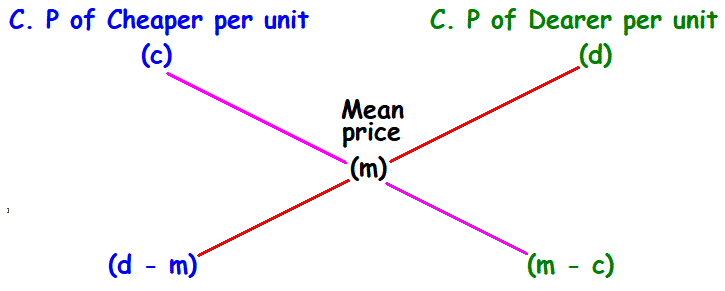ALLIGATION OR MIXTURE
Subscribe to our ▶️ YouTube channel 🔴 for the latest videos, updates, and tips.
Key Concept
1. Alligation or Mixture :
This is a rule which we can use to find the ratio in which we have to mix two or more types of ingredients to produce the mixture in a desired price.
2. Mean price :
The cost price of the mixture per given unit is called mean price.
3. Rule to find the ratio for producing mixtures :

To produce the mixture, the ratio in which the cheaper and dearer to be mixed is
= (d - m) : (m - c)
4. Say, a bucket has x units of liquid. From which y units of liquid taken out and replaced by water. After repeating this process n times, the quantity of pure liquid is
Example 1 :
What is the ratio in which the two types of wheat mixed where the price of the first type is $9.30 per kg and the second type is $10.80 per kg so the mixture is having worth $10 per kg?
Solution :
From the given information, we have
cost price of the cheaper (c) = $9.30
cost price of the dearer (d) = $10.80
cost price of the mixture (m) = $10
Rule to find the ratio for producing mixture is
= (d - m) : (m - c)
So, we have
(d - m) : (m - c) = (10.8 - 10) : (10 - 9.3)
(d - m) : (m - c) = 0.8 : 0.7
(d - m) : (m - c) = 8 : 7
So, the ratio in which the first kind and second kind to be mixed is 8 : 7.
Problem 2 :
Find the ratio in which, water to be mixed with milk to gain 20% by selling the mixture at cost price.
Solution :
Let us consider the water as cheaper and milk as dearer.
Let the cost price of 1 ltr of pure milk be $1 and water be $0.
Now we take some quantity of milk (less than 1 ltr), add some water and make it to be 1 ltr milk-water mixture.
Let x be the cost price in 1 ltr of the mixture.
Because the gain is 20%, selling price of 1 ltr of the mixture is
= x + 20% of x
= x + ²⁰ˣ⁄₁₀₀
= ¹⁰⁰ˣ⁄₁₀₀ + ²⁰ˣ⁄₁₀₀
= ⁽¹⁰⁰ˣ ⁺ ²⁰ˣ⁾⁄₁₀₀
= ¹²⁰ˣ⁄₁₀₀
= ⁶ˣ⁄₅
Given : The mixture is sold at the cost price of pure milk.
That is,
S.P of 1 ltr of mixture = C.P of 1 ltr of pure milk
⁶ˣ⁄₅ = 1
Multiply both sides by ⅚.
x = ⅚
So, the cost price of 1 ltr of the mixture is $⅚.
Now, we can consider the following points.
Cheaper : Cost price of 1 ltr water (c) = $0
Dearer : Cost price of 1 ltr pure milk (d) = $1
Mean price : Cost price of 1 ltr mixture (m) = $⅚.
Rule to find the ratio for producing mixture is
= (d - m) : (m - c)
Then, we have
(d - m) : (m - c) = (1 - ⅚) : (⅚ - 0)
(d - m) : (m - c) = ⅙ : ⅚
(d - m) : (m - c) = 1 : 5
So, water and milk have to be mixed in the ratio to gain 20% is 1 : 5.
Problem 3 :
The milk and water in two vessels A and B are in the ratio 4:3 and 2:3 respectively. In what ratio, the liquids in vessels A and B be mixed to obtain a new mixture in vessel C consisting half milk and half water?
Solution :
Let the cost price of 1 liter pure milk be $1.
Amount of milk in 1 liter of mixture in A = ⁴⁄₇ liters
Amount of milk in 1 liter of mixture in B = ⅖ liters
Amount of milk in 1 liter of mixture in C = ½ liters
Let us assume the cost price of the liquid mixture in A as cheaper, B as dearer and C as mean price.
cost price of 1 liter mixture in A (c) = $⁴⁄₇
cost price of 1 liter mixture in B (d) = $⅖
cost price of 1 liter mixture in C (m) = $½
Rule to find the ratio for producing mixture is
= (d - m) : (m - c)
So, we have
(d - m) : (m - c) = (⅖ - ½) : (½ - ⁴⁄₇)
(d - m) : (m - c) = ⁽⁴ ⁻ ⁵⁾⁄₁₀ : ⁽⁷ ⁻ ⁸⁾⁄₁₄
(d - m) : (m - c) = -⅒ : -¹⁄₁₄
(d - m) : (m - c) = ⅒ : ¹⁄₁₄
Least common multiple of (10, 14) is 70.
So, multiply both the terms of the ratio ⅒ : ¹⁄₁₄ by 70.
(d - m) : (m - c) = ⁷⁰⁄₁₀ : ⁷⁰⁄₁₄
(d - m) : (m - c) = 7 : 5
So, the ratio in which the liquids in vessels A and B be mixed is 7 : 5.
Problem 4 :
A dealer mixes tea costing $6.92 per kg with tea costing $7.77 per kg and sells the mixture at $8.80 per kg and earns a profit of 17.5 % on his sale price. In what ratio does he mix them?
Solution :
Given : The mixture is sold at $8.80 per kg and 17.5% profit earned on the sale price.
Profit = 17.5% of 8.80
Profit = 0.175 ⋅ 8.80
Profit = 1.54
Then the cost price of of the mixture is
= Selling price - Profit
= 8.80 - 1.54
= 7.26
Let the cost price of tea costing $6.92 per kg as cheaper and $7.77 as dearer.
Then the mean price is $7.26.
More clearly,
cheaper (c) = 6.92
dearer (d) = 7.77
mean price (m) = 7.26
Rule to find the ratio for producing mixture is
= (d - m) : (m - c)
So, we have
(d - m) : (m - c) = (7.77 - 7.26) : (7.26 - 6.92)
(d - m) : (m - c) = 0.51 : 0.34
(d - m) : (m - c) = 51 : 34
(d - m) : (m - c) = 3 : 2
So, the required ratio is 3 : 2.
Problem 5 :
A container has 10 liters of milk. 1 liter of liquid is taken out and replaced by water. If this processed is repeated thrice, find the amount of pure milk in the container.
Solution :
The formula to find the amount of pure milk is,
= x ⋅ (1 - ʸ⁄ₓ)n
Here,
x = 10 ltrs
y = 1 ltr
n = 3
Then, we have
= 10 ⋅ (1 - ⅒)3
= 10 ⋅ (¹⁰⁄₁₀ - ⅒)3
= 10 ⋅ (⁹⁄₁₀)3
= 10 ⋅ (0.9)3
= 10 ⋅ 0.729
= 7.29
So, the amount of pure milk in the container will be 7.29 liters.
Subscribe to our ▶️ YouTube channel 🔴 for the latest videos, updates, and tips.
Kindly mail your feedback to v4formath@gmail.com
We always appreciate your feedback.
About Us | Contact Us | Privacy Policy
©All rights reserved. onlinemath4all.com

Recent Articles
-
10 Hard SAT Math Questions (Part - 40)
Dec 25, 25 08:30 AM
10 Hard SAT Math Questions (Part - 40) -
10 Hard SAT Math Questions (Part - 41)
Dec 24, 25 07:58 PM
10 Hard SAT Math Questions (Part - 41) -
ASTC Formula in Trigonometry
Dec 23, 25 11:34 PM
ASTC Formula in Trigonometry - Concepts - Examples and Solved Problems


